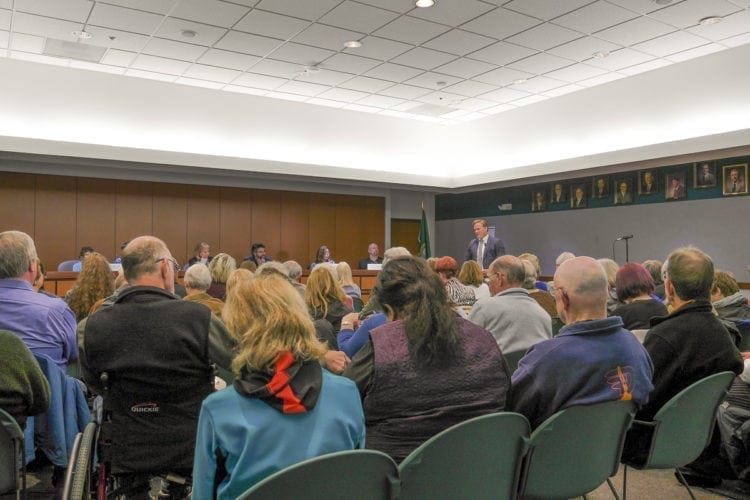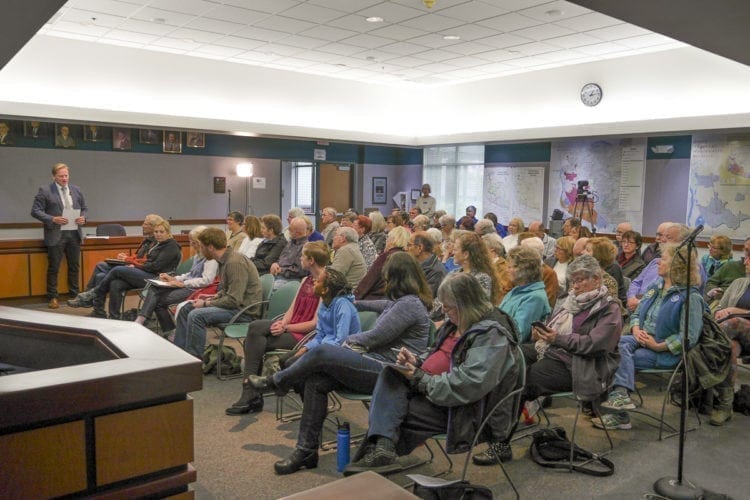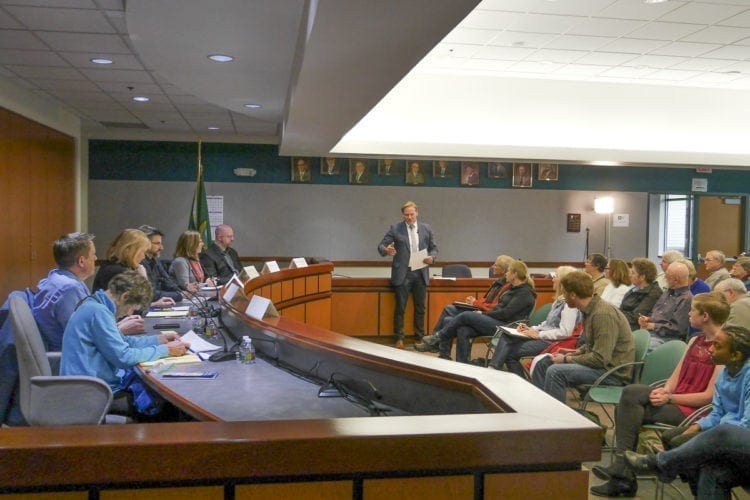The League of Women Voters of Clark County hosted the forum with seven area leaders
VANCOUVER — It was a packed house Sunday afternoon at the Clark Regional Wastewater District building in Hazel Dell, as the League of Women Voters of Clark County hosted a forum to discuss local transportation issues.
A panel of six area leaders — including Vancouver Mayor Anne McEnerny-Ogle, Washington State Department of Transportation Regional Director Kris Strickler, and C-Tran CEO Shawn Donaghy — answered questions posed by moderator Matt Ransom, executive director of the Southwest Washington Regional Transportation Council, as well as a few questions posed by the audience.

Ransom started off the two-hour forum with a couple questions: “How many of you think we live in a rural county? Now how many of you think we live in an urban county?”
Ransom pointed out that Clark County’s population is now closing in on half a million people, with another 200,000 expected in the next couple of decades.
“So the questions that we’re confronted with are about how will we accommodate for that,” Ransom said. “How do we build a community that’s not one dimensional?”
He went on to point out that space to build roads is limited by law, so the answers about how to make sure everyone can get where they need to go as quickly as possible must fall within those boundaries.
It’s part of a fairly recent idea, as McEnerny-Ogle pointed out, called “Complete Streets.” The group Smart Growth America defines Complete Streets as streets that “are designed and operated to enable safe access for all users, including pedestrians, bicyclists, motorists and transit riders of all ages and abilities.”
McEnerny-Ogle mentioned that not long ago council members and city staff were taken down Main Street by a member of the School for the Blind, as well as a wheelchair-bound citizen, and she was amazed at how many barriers people like that face when it comes to safely getting around.
“You think about all the stuff that is on a sidewalk,” the mayor said, “the signs, those little bump outs with tables and chairs and fences, the trees that we purposely put there. Then all the newspaper stands and the bike racks. It led us to believe that we had a lot of learning to do.”
McEnerny-Ogle also recalled moving to Vancouver in 1980 and trying to meet up with her fiance at the old library, only to find out she couldn’t get there by walking due to a lack of sidewalks. Temple Lentz with the Clark County Committee on Aging said the area where she lives in Hazel Dell is only about a mile from a bus stop, but walking there is challenging still, with sidewalks missing and dangerous intersections.

That issue becomes more important when you realize Clark County has a higher percentage of people over the age of 60 than most places in the country — currently 1-in-6, and expected to climb higher in the coming years. As Lentz pointed out, making sure the elderly have a system that makes it easy to get around when they can no longer drive is at least partly a matter of mental health, as isolation is connected with a higher rate of depression in the elderly.
The concept of Complete Streets also includes space for bicyclists, something many cycling enthusiasts believe Clark County has been slower to embrace than places like Portland. Several people biked to the forum, despite the pouring rain. A pile of clothing at the back of the room belonging to Madelein von Laue with the Vancouver Bike-Ped Stakeholder Group testified to her dedication to navigating on two wheels.
“I joke that I have a bad case of Portland envy,” von Laue said, “because over there they have all these green bike boxes, and lots of ways to make roads safer for cyclists. But we’re working on it.” von Laue added that both the city and the county have been receptive to the concerns of the cycling community, and committed to finding solutions.
On side streets that may translate into less room for vehicles as the city puts safety above traffic flow.
“Pedestrian safety is a huge problem right now,” says McEnerny-Ogle. “What’s causing that? Is it distracted drivers? Probably. We may be looking at a road diet, and it’s not going to be an easy thing of taking four lanes down to three – one in each direction and a center turn, but as we look at it we are re-building and building new roads with this idea of Complete Streets.”
C-Tran figures to play a big part in the future of transportation in Clark County. CEO Shawn Donaghy claimed that ridership along the VINE Rapid Transit line on Fourth Plain is up 45 percent in the last year. The agency, and the city, are hoping to expand the system to Mill Plain in the near future, and eventually to Highway 99 in Hazel Dell.
Trouble down south
Of course no conversation on Transportation in Clark County would be complete without touching on the I-5 Bridge and the possibility of tolling on I-5 and I-205 in Portland.
Mayor McEnerny-Ogle was frank when she discussed the fate of the Columbia River Crossing project, which was scrapped five years ago.
“Oregon approved it, Oregon had money available for it,” she says, “we took it up to (Olympia), and we lost it. It was our responsibility to pull money out of the Washington Legislature and that didn’t happen … There are a lot of hard feelings. We came to the table, and we lost it. So they’re very reluctant to go out on a limb again.”

Kris Strickler, regional director for WSDOT, said they have put together what they’re calling a Forage Binder, containing information about what studies from the Columbia River Crossing project might still be usable on any new bridge design. He and the mayor said conversations are continuing about the project, but it’ll require new funding from the Federal government, and a lot of work on both the state and local levels.
Meanwhile the conversation continues in Oregon about Value Pricing. Those words were rarely uttered at this forum — instead people just said “tolling”. McEnerny-Ogle and Strickler are two of the three Southwest Washington representatives on the 25-member Value Pricing Advisory Committee, and each expressed their growing dismay with the fact revenue from tolling in Oregon likely would do nothing to alleviate the congestion issues Clark County drivers face.
Chris Striver, a member of the League of Women Voters, was on the panel to represent the average driver. He commutes from the Battle Ground area to Hillsboro 3-4 times per week, and says he’s seen the backup on the north side of the bridge in the morning go from Mill Plain to Fourth Plain, and now SR-500 by 6 or 7 in the morning.
“As a Washingtonian working in Oregon I pay $4,000 to Oregon every year in state income tax,” Striver says, “so as far as I’m concerned Oregon is a bad actor in all of this. Makes it really difficult to be kind.”
While the politicians in the room stopped short of Striver’s harsh criticism of Oregon, there was consensus that the general rule behind tolling is to fix the problem. Whether it’s to pay for a new bridge, to expand a highway, or incentivise mass transit or carpooling, charging more to drive on a stretch of road, the panel agreed, should raise money aimed at solving that problem. Currently the money raised in Oregon couldn’t even be used to benefit C-Tran, which is actually the fourth-largest mass transit agency in that state.
Learning from others
Ultimately the strength of the local transportation system could come from anywhere. As McEnerny-Ogle pointed out, the usage of roundabouts started in east Vancouver, and spread to Camas and Ridgefield. Portland picked up C-Tran’s Bus Rapid Transit idea. Other ideas have come from all over the world.
The future, of course, is hard to predict. Will self-driving cars be the end of gridlock, or simply mean more people on the roads? Can higher-speed wireless technology enable more people to work from home, thus reducing the number of commuters? As Ransom put it, learning to drive a car will someday be a hobby rather than a necessity.
Whatever our system of roads and bridges becomes, however, public input is the key to making it work for everyone. The panel stressed the importance of ordinary citizens making sure their voices are heard, either by sending letters and e-mails, or attending meetings and signing up for committees. Having a diverse group of people shaping policy, from drivers, to bus riders, cyclists and pedestrians, they stressed, makes sure we ultimately end up with a system that works for everyone.




